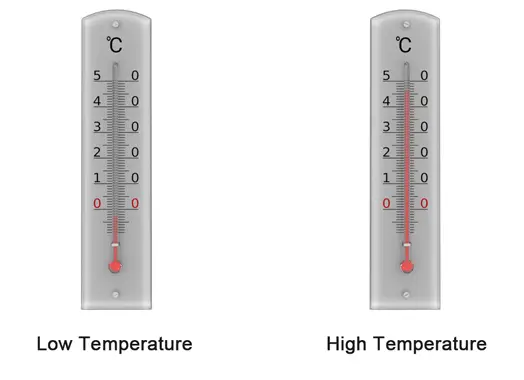Thermal Expansion
What is Thermal Expansion
When a material undergoes a change in temperature its size tends to expand or shrink depending on the type of material. This phenomenon is known as Thermal expansion, which can be defined as the change in shape, area, or volume of a material when its temperature changes.
When materials are heated, the molecules and atoms that make up the material become more energetic and move farther apart, causing the material to expand. Conversely, when materials are cooled, the molecules and atoms become less energetic and move closer together, causing the material to contract. This phenomenon occurs in all materials, but the degree of expansion or contraction can vary depending on the material’s physical and chemical properties.

That is actually how a thermometer works, when the temperature rises, the mercury within the glass tube expands, and it contracts when the temperature falls.
Thermal expansion is an important phenomenon in many fields, including engineering, construction, and materials science. Understanding thermal expansion is critical for designing and constructing structures and components that can withstand changes in temperature without failure or damage.
Types of Thermal Expansion
There are three types of thermal expansion: Linear expansion, area expansion, and volume expansion.
1) Linear Expansion
Linear expansion occurs when a material expands or contracts in one dimension only. The change in length of a material due to thermal expansion is given by the coefficient of linear expansion (αL).
The formula for linear expansion is ΔL = αL Lo ΔT Where:
- ΔL is the change in length
- Lo is the original length
- ΔT is the change in temperature
- αL is the coefficient of linear expansion
2) Area Expansion
Area expansion occurs when a material expands or contracts in two dimensions. The change in area of a material due to thermal expansion is given by the coefficient of area expansion (αA).
The formula for area expansion is ΔA = αA Ao ΔT Where:.
- ΔA is the change in area
- A is the original area
- ΔT is the change in temperature
- αA is the coefficient of area expansion
3) Volume Expansion
Volume expansion occurs when a material expands or contracts in all three dimensions. The change in volume of a material due to thermal expansion is given by the coefficient of volumetric expansion (αV).
The formula for linear expansion is ΔV = αV Vo ΔT Where:
- ΔV is the change in volume
- Vo is the original volume
- ΔT is the change in temperature
- αV is the coefficient of volume expansion
Coefficient of Thermal Expansion
The coefficient of thermal expansion (CTE), denoted by the letter (α) "alpha", is the rate at which the shape, area, or volume of a material changes with respect to a change in temperature. In other words, it’s the fractional change in size per unit of temperature. The SI unit of thermal expansion coefficient is inverse kelvin (K-1), other common units are inverse celsius (°C-1) and inverse fahrenheit (°F-1).
For isotropic materials (materials that exhibit the same mechanical properties in all orientations) and under constant pressure, the coefficient of thermal expansion for each type can be found as:
- Coefficient of linear expansion
Coefficient area or superficial expansion
- Coefficient volume expansion
The coefficients of thermal expansion are found to be related, and the relation between the linear, area, and volume expansion coefficients can be expressed as: 3αL = 1.5αA = αV
You can find the coefficient of thermal expansion for common material on this page: CTE of common materials
Thermal Expansion Calculation
An aluminum bar has an initial length of 100 m at -15°C, find the change in length due to thermal expansion when we increase the temperature to 30°C. (The linear thermal coefficient for aluminum is 22 x10-6°C-1)
Lo = 100 m To = -15°C T = 30°C αL = 22 x10-6°C-1
Step 2) We find the temperature difference:
ΔT = T - To = 30 - (-15) = 45°CStep 3) Now, we can find the change in length:
ΔL = Lo αL ΔT = 100 x (22 x10-6) x 45 = 0.1 mThe final length of the bar would be the initial length plus the change in length:
LF = Lo + ΔL = 100 + 0.1 = 100.1 mWe can use the same procedure with the area and volume thermal expansion formulas to find the change in area and volume, respectively.
Factors Affecting Thermal Expansion
There are several factors that can affect the thermal expansion of a material, including:
- Chemical composition: The chemical composition of a material can affect its thermal expansion behavior. Different materials have different crystal structures and bonding arrangements, which can lead to different thermal expansion coefficients.
- Temperature range: The temperature range over which a material is exposed to can affect its thermal expansion behavior. Different materials can have different thermal expansion coefficients at different temperature ranges.
- Initial dimensions: The initial dimensions of a material can affect its thermal expansion behavior. Materials with larger initial dimensions may experience greater dimensional changes due to thermal expansion than materials with smaller initial dimensions.
- Environmental conditions: The environmental conditions to which a material is exposed can affect its thermal expansion behavior. For example, exposure to humidity or moisture can affect the thermal expansion of some materials.
- Manufacturing processes: The manufacturing processes used to produce a material can affect its thermal expansion behavior. Factors such as the cooling rate and annealing process can affect the crystal structure and bonding of the material, which can in turn affect its thermal expansion coefficient.
Applications of Thermal Expansion
Thermal expansion has many practical applications in various fields. Some of the main applications of thermal expansion are:
- Construction: The expansion and contraction of materials due to changes in temperature are important considerations in construction. Buildings, bridges, and other structures are designed to accommodate thermal expansion to prevent damage and ensure longevity.
- Plumbing and piping systems: The expansion and contraction of pipes due to changes in temperature can cause stress and damage to the system. The use of expansion joints, flexible connectors, and other devices can help to accommodate thermal expansion and prevent damage.
- Aerospace and aviation: Thermal expansion is an important consideration in the design and manufacture of aircraft and spacecraft. Materials with low thermal expansion coefficients are often used to ensure stability and accuracy of measurements and instruments.
- Electronics and semiconductors: The thermal expansion of materials is a critical consideration in the manufacture of electronic components, such as printed circuit boards and microchips. Proper control of thermal expansion can help to prevent stress and damage to these delicate components.
- Glass manufacturing: Thermal expansion is an important consideration in the manufacturing of glass products, such as windows, mirrors, and lenses. Control of thermal expansion ensures the quality and durability of these products.
Thermal Expansion Design Considerations
When designing a product or structure, there are several important considerations to take into account in order to accommodate thermal expansion. These considerations include:
- Material selection: The coefficient of thermal expansion varies for different materials. When selecting materials for a product or structure, it is important to consider the material’s coefficient of thermal expansion and how it may affect the overall design.
- Joint design: Joints and connections must be designed to allow for thermal expansion and contraction. If joints are too rigid, they can cause stress and damage to the structure or product. Expansion joints, slip joints, and other flexible connections can be used to accommodate thermal expansion.
- Temperature range: The range of temperatures that the structure or product will experience must be taken into consideration. The coefficient of thermal expansion can vary depending on the temperature range, so the design must account for these variations.
- Fastening methods: The method of fastening used in the design can also impact how well the product or structure can accommodate thermal expansion. Fasteners that are too rigid or inflexible can cause stress and damage, while flexible fasteners can allow for thermal expansion and contraction.
- Testing and validation: Once the design is complete, it’s important to test and validate it to ensure that it can accommodate thermal expansion and contraction. Testing can help identify any areas where the design may need to be improved or modified to ensure its ability to handle thermal expansion.
Overall, thermal expansion is an important principle in various fields and plays a crucial role in the design and manufacture of numerous products and structures. Understanding the effects of thermal expansion and how to control it is essential in ensuring the reliability, durability, and safety of these products and structures.
Thermal Expansion Summary | |
|---|---|
| Definition | The material’s change in length, area, or volume when its temperature changes |
| Symbol | Thermal expansion coefficient symbol (α) |
| Formulae | Linear expansion (ΔL) = Lo αL ΔT |
| Area expansion (ΔA) = Ao αA ΔT | |
| Volume expansion (ΔV) = Vo αV ΔT | |
| Units | Thermal expansion coefficient units (K-1, C-1, or F-1) |
Frequently Asked Questions
- What causes thermal expansion?
- Thermal expansion is caused by the increase in temperature of a material, which causes its constituent particles to vibrate more and take up more space. This results in an overall increase in the size of the material, which is known as thermal expansion. The degree of expansion depends on the type of material and the temperature change it experiences.
- Can thermal expansion coefficient be negative?
- Yes, the coefficient of thermal expansion (CTE) can be negative for certain materials, although this is relatively uncommon. A negative CTE means that the material will shrink or contract as the temperature increases, which is the opposite of what is typically observed with most materials.
- Does thermal expansion affect density?
- Yes, as density is inversely proportional to volume, an increase in a material’s volume due to thermal expansion would decrease its density and vice versa.
- Does thermal expansion lead to sea-level rise?
- There are several factors affecting the sea-level rise, like the melting of ice, however, thermal expansion is responsible for about half of the global sea-level rise on Earth.
- Can thermal expansion cause structural damage?
- Yes, thermal expansion can cause structural damage if it is not properly accounted for in the design of a structure. When a material heats up, it will expand, and if it is constrained or cannot move freely, the resulting stress can cause damage to the structure.
- Can thermal expansion be controlled or reduced?
- Yes, thermal expansion can be controlled or reduced in some cases. One approach is to use materials that have a lower coefficient of thermal expansion (CTE), which will exhibit less expansion and contraction with changes in temperature. Another approach is to incorporate features into a design that allow for movement or flexibility, such as expansion joints, which can help to reduce stress on the structure caused by thermal expansion.
- Does thermal expansion occur in all materials?
- Yes, thermal expansion occurs in all materials to some degree. The degree of expansion will depend on the type of material and the temperature change it experiences. Some materials may expand more than others, depending on their composition and structure, but all materials will exhibit some level of thermal expansion when subjected to temperature changes.
